I don’t know the key to success, but the key to failure is trying to please everybody.
—Bill Cosby 1
Wherever you go, there you are.
—Anonymous
Our deepest fear is not that we are inadequate. Our deepest fear is that we are powerful beyond measure. It is our light, not our darkness, that most frightens us. We ask ourselves, “Who am I to be brilliant, gorgeous, talented, and fabulous?” Actually, who are we not to be? . . . Your playing small doesn’t serve the world. There’s nothing enlightened about shrinking so that other people won’t feel insecure around you. We were born to make manifest the glory . . . that is within us. It is not just in some of us; it’s in everyone. And as we let our own light shine, we unconsciously give other people permission to do the same. As we are liberated from our own fear, our presence automatically liberates others.
—Nelson Mandela 2
The Group Mind
Because it is impossible to build community all by yourself, learning and embracing a functional group process becomes as important a skill as building good compost. If you find yourself organizing community projects, you must learn to facilitate good communication and effective working relationships if you want those projects to succeed.
Community groups share workloads, resources, and information with one another and with other communities. Living and working together in community is a natural instinct of humans and many other animals—just look at wolves, chickens, and elk. Most people love spending time with their friends and families; in fact, community and companionship are essential to our mental health.
Some people prefer to work alone, and I fully encourage an individual’s right to be empowered by her own ideas. However, I also believe that a brilliant idea comes with the responsibility to share it. Take credit for your ideas, but make them real or let them go like any other surplus. Even if you are allergic to meetings, you can’t work in groups, or you do your most effective work by yourself, you owe it to your community and your planet to find a way to share your work.
Especially in urban environments, where we have the potential to interact with dozens and sometimes hundreds of people a day, it is essential to our ecological health that we learn to communicate and get along with others. Luckily this can be an immensely fun and rewarding experience. Like any system, a good working group is greater than the sum of its parts. You can achieve much more together than as individuals and can set an example of cooperation and peaceful interaction.
It can also be a very painful and frustrating experience, depending on how well the group is able to get along. In some groups the members seem to have a mystical connection with one another, agreeing on every step of the process. In my experience this is extremely rare. Other groups are just the wrong mix of personalities; these groups quickly erupt into dysfunctional chaos, and nothing ever gets accomplished. This is also relatively rare. Most groups are somewhere in between, and the faster those groups can find a functional process for sharing ideas, making decisions, taking action, and solving problems, the better equipped they will be to realize their collective goals.
Interacting with other people is one primary way in which we get to know one another and ourselves, and the best way to build healthy communities. Yet effective human interaction is a skill rarely taught in conventional settings. In this chapter I will outline some of the more effective methods for developing and maintaining a functional group process and will examine some solutions to the inevitable problems that occur.

Making Decisions
When you start sharing ideas and developing projects with a group, you will eventually have to arrive at some decisions together. What will you do as a group? Where is your basis of unity? What actions will you take and why? How will you go about your work, and what problem-solving tools will you use?
In mainstream Western culture, and especially in the United States, most people seem to support some form of voting-based decision making. Even many radical activists speak often of voting and constitutional rights. These people eschew dictatorships, theocracy, communism, and other forms of government for being authoritarian, patri-archical, and oppressive.
Yet most examples of voting-based processes today are merely some form of authoritarianism in disguise. We vote, we watch the news, and the rich white men in power continue to bomb a new country every year. When we go out in the streets and exercise the meager “constitutional rights” afforded us, we go to jail and get shot by the police whose salaries we are forced to pay. This is not my idea of a free country, nor do I feel included in the decision-making process.
Voting-based systems rely on a majority rule, by which any leader or decision that receives the most votes wins. But what about the minority voters? Often those who are consistently outvoted feel powerless and disenfranchised. Sometimes these people will just leave the group, taking their ideas and resources with them.
Other times people will continue to work with the group but will be bitter and less invested in the outcome. A few will even take action in an effort to be heard and represented and may even sabotage a project. This occurs on some scale in every democracy, as is evident in the constant civil unrest in this country and most of the world. Not that other forms of rule don’t provoke unrest, dissatisfaction, and often revolution. Quite the contrary, which is why we need to make finding ways to cooperate with one another a top priority.
A functional working group can accomplish far more than the sum of its individuals.
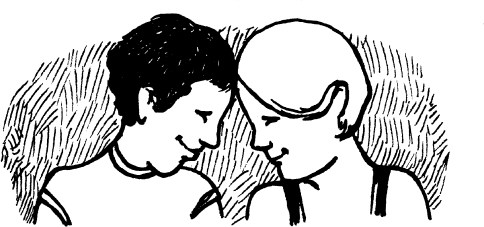
Without getting so deep into political analysis that I can’t dig myself out before garden season, I will just say that I much prefer, and highly recommend, an egalitarian decision-making process, such as consensus, for collective projects.
Consensus embraces the principle of cooperation.
Consensus and Shared Leadership
Consensus-based groups make an agreement to reach agreement on every decision. Any single person can block any decision if she feels it will inhibit or detract from the goals or integrity of the group, and the concerns of even a small minority are given equal weight as those of the majority. This is the most egalitarian form of group process, as it embraces the needs and ideas of every individual. When people share decision-making power, they also share responsibility for the impact of those decisions. They become invested in the project and devoted to the collective outcome.
Consensus is not voting, nor is it compromise. Consensus is synergy; it is the symbiotic will of the group, expressed through finding a unified goal and sharing responsibility for achieving it. In many ways just participating in a consensus process empowers the community more than the resulting projects. The empowerment—and the learning—comes through the process as much as the product. The medium is still the message.
Consensus embraces the principle of cooperation, meaning tolerance of others’ mistakes and willingness to learn from our own. None of this means there is no leadership; in fact, all members of the group should be encouraged to use their leadership skills to help ensure the fairness and effectiveness of each decision. The key to functional equality is not in denying power but in learning to share and respect it as a valuable and malleable resource. Like fire, water, work, and sex, power in many forms flows through all elements in our gardens and communities, and the more comfortable we can become with it, the better.
The Collective Process
Often consensus-based groups call themselves collectives. Most collectives come together via one or several group meetings. I have attended many different kinds of meetings. Some of them felt like a psychospiritual rejuvenation—a divine merging of the group mind, focused together toward a common, perfect goal. Other meetings felt like an eternity in the lowest circle of hell, with every interpersonal drama ever known to humankind dragged through the same communal pit at once. The primary difference between these meetings was the ability of the participants to conduct calm, mature relationships and to define and stick to clear, mutual boundaries.
The process described below deviates from traditional consensus formats that are based largely on parliamentary-style meetings, where everyone is forced to listen to the tireless rantings of the few and the call for consensus feels eerily like voting. I find such meetings long and frustrating, and rarely do they result in much action. Nothing breaks a project down faster than when the participants stop communicating, and nothing makes them stop communicating faster than when the communication process (usually meetings) becomes boring, hostile, or tedious.
Luckily long, boring meetings are not the only way to achieve powerful, consensus-based results. The process I prefer relies heavily on ecological design theory, using a systematic approach to finding and expressing the group will. Thus meetings become more like workshops, with an emphasis on action rather than rhetoric, and on building community through cultivating a powerful group dynamic rather than watching it deteriorate into dysfunctional, hypothetical chatter. But the collective process doesn’t stop at the meeting. The meeting is only the launching pad for the action to follow. In the next few pages we’ll work through a functional collective process, from the first meeting to the realization of unified goals.
A Semiformal Sharing of Ideas
Meetings should be short, informative, and fun, though sometimes with moments of tension and sincere seriousness. Use your meeting time to get the job done: Identify goals, objectives, and resources; delegate tasks; and share information about finished work and upcoming opportunities. I recommend not scheduling regular meetings (such as every Tuesday at five) but rather encouraging everyone in the collective to call a meeting whenever they feel they need to talk with more than a few people at a time about a project. This will help you avoid pointless meetings and will encourage shared leadership.
Schedule meetings for a specific time, say from 6 to 8 PM on a weeknight, at a public place that closes early. This will help avoid long, dragged-out sessions that leave people feeling burned out and ready to skip the next meeting.
The convener—the person who called the meeting—arrives first and greets everyone as they come in. When everyone has arrived, they sit in a circle and a few people agree to take on a rotating leadership role for the meeting. Lasting for the duration of the meeting, the roles help the process move quickly yet comprehensively toward a common goal and plan for action. These roles vary from group to group but generally include a note keeper, a public scribe, a timekeeper, a “vibeswatcher,” and a facilitator or two.
The note keeper keeps a detailed log of everything that is said and by whom and makes these notes available later, as needed. The note keeper also keeps track of important points and agreements made by the group, and the public scribe uses a chalkboard or large piece of paper to post these pertinent points during the meeting for all to see and relate to. The timekeeper offers friendly reminders when one person is talking for too long or the group becomes caught on a topic for longer than agreed. The vibeswatcher helps keep the conversation from becoming abusive and speaks up when mediation is needed or when the whole group needs to take a break.
Finally, the role of facilitator is to encourage egalitarian participation, prevent interruptions, and try to keep the group on topic. The facilitator is the anchor of the meeting. She keeps the meeting on track, moving the flow of conversation toward a solution and, ultimately, an action. She does not direct the meeting toward her own agenda but rather seeks opportunities to help bring the group toward a harmonized synthesis of collective will.
The role of facilitator, while not necessarily the most important, is often the most active and vocal and tends to fall into the hands of the most vocal, most leadership-inclined person in the group. If you want to effectively balance the flow of power, however, it is essential to rotate this and the other roles from meeting to meeting. (See the sidebar Seven Ways to Share Power for more ways to share power and leadership in a group.)
Once people have chosen roles for the meeting (this shouldn’t take more than five minutes), the real fun begins. Here you have as many options as ways you can think of to communicate. The classic format involves taking turns speaking, moving through a list of agenda items, and working toward agreement. But sometimes it is more effective to have a “mingling meeting” in which participants group together at will, discussing topics that need to be discussed among the people who need to discuss them. The facilitator, note keeper, and vibeswatcher are still working; they are mingling too.
Sometimes the facilitator starts a go-around in which each person gives her name and a very brief introduction. Introductions can be a statement of purpose (What do I want to get out of this project?) or the answer to an ice-breaker question (Who has inspired me the most and why?). Some groups will also do a regular check-in where participants say how they are feeling personally, physically, and emotionally. These go-arounds can eat up the entire meeting time, so especially in a working group, where the same people meet often, consider skipping this step and getting right to work. You can always solve personal problems and get to know one another in a separate meeting, with a format focused on those things.
After introductions the collective either picks up unfinished business from a previous meeting or launches into a fresh brainstorming session about the topics the group wants to focus on. What are the relevant problems that you share? What do you collectively want to do about those problems? Cultivate your collective passion and develop some compelling ideas for action.
Sometimes it helps to brainstorm a list of agenda items first, and even to assign time limits to each item. Then work through the list and hash out each item in turn. Other times it is better to just let the group free-flow through an assortment of ideas, then come to a shared vision through a more organic process. Similarly, some collectives are comfortable with a raucous everyone-talks-at-once process, while others need a more orderly atmosphere. Check in with one another and be sure you’re not oppressing yourselves.
Again, none of these activities needs to be done in a parliamentary, raise-your-hand-and-don’t-speak-out-of-turn fashion. Some people have a hard time being comfortable in a group where everyone is talking at once, approaching the people they need to connect with, and writing tasks on a central board. Yet this same format, while chaotic to some, is highly effective for others. And just as it is crucial for the more boisterous members of a group to make room for quiet people, it is equally important for those timid folks to find the courage to speak up, assert themselves, and be heard.
In my opinion the most effective meetings are a blend of the above strategies, with time for getting to know one another, time for mingling, and time for carefully facilitated planning. Remember that a group process is like a garden design: You can get a plethora of ideas from books and examples, but you will ultimately need to develop a process that responds to the specific needs and desires of your unique situation. Talk with your group about the process, and find something that feels good to everyone.
Following Through
After a good brainstorming session, some interesting proposals should begin to take shape. Or perhaps someone has arrived at the meeting with a specific plan that she wants the group to follow. Either way, options should be moving away from the theoretical and toward the specific things you can do together to achieve a common goal.
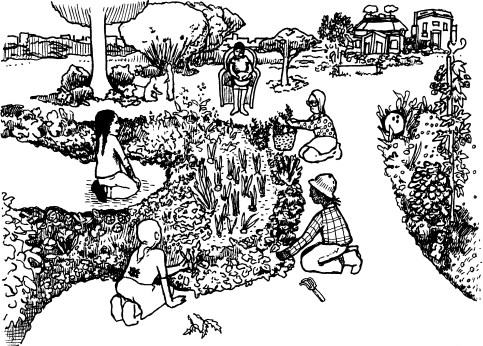
Have a working meeting in the garden to avoid some of the stagnation that can occur in boardroom-style settings.
At this point the most common scenario is for a couple of proposals to form and for the group to either vote or argue over which one to choose. In an egalitarian group process, however, it often proves much more effective to turn to a design process like Gobradime (see chapter 7) to develop a specific set of actions in response to your specific collective theory. Have everyone in the group define their personal goals, observations, boundaries, and so on. Find threads of commonality and weave them into a synergistic plan of action. You can also have each person take a step back and brainstorm about it, then come back together and synthesize your ideas.
Throughout this process, consistently test for consensus. This means asking whether anyone in the group has concerns, questions, or problems with either the process or the potential products of your collective work. Consensus does not mean that everyone thinks the decision is the best one possible, or that they are sure it will work. It does mean that everyone feels included in the decision, that no person has decision-making power over any other, and that no one feels alienated by the process. For this to work everyone in the group must trust and respect one another and must be honest about their needs and resources.
Don’t waste your time discussing what shouldn’t happen; focus instead on what the group can agree to do together. Sometimes certain parts of a project will appeal to some but not others. Define which parts should be left out because they are inappropriate, and which other pieces will remain because, while unappealing to some, they are still important for the project. People sometimes feel they have to block a decision when they really just need to find a different place to plug into the project. Remember that you all agreed to agree on everything, so take time to listen to what everyone feels, wants, and doesn’t want to do.
As you work your way through the labyrinth of the group mind, continue to push the process toward the practical ways in which you can manifest your collective goals. If you are using Gobradime, it will lead you directly toward task assessment. This is the essential step in turning theoretical dreaming into focused, tangible action. Work together to develop a list of tasks the group will need to accomplish in order to meet collective goals, and organize those tasks into loose chronological order.
Because consensus groups are based on everyone agreeing to every facet of the project, the ideal is for the whole group to collaborate on a list of tasks. However, it takes far less time and usually works out fine if most tasks are delegated to small working groups and only the most challenging tasks (such as achieving a shared vision or raising a lot of money) are kept within the large group (see the sidebar Ideas into Action). Do what makes sense for the project and collective at hand, but again be receptive to one another and don’t go against the large-group decisions by putting tasks on your own list that you know others will strongly oppose.
When Problems Arise
The key to a functional consensus process is the willingness of the participants to trust one another and their ability to conduct mature, responsible relationships. Abusive or otherwise dysfunctional people will find egalitarian group process difficult or impossible.
Sometimes there are minor personality conflicts that can be overcome through some simple problem-solving strategies. Other times it is better for a person to leave the group or for the group to dismantle. Try to see this not as a failure but as an opportunity to learn and branch off in new directions. Just as in the garden, not every experiment will succeed; the only mistake is refusing to recognize patterns and opportunities.
If you are having trouble finding common ground or getting things accomplished, work through the following steps to look for solutions. These are just a few ideas; experiment with your own collective and individual communication styles to find specific problem-solving techniques that work for you.
Check Your Head
If you find yourself frustrated or disenchanted with your group, the first step is to check your own behavior. As individuals, the best way to contribute to a peaceful society is to be peaceful people. Personal growth is an ongoing process, and if we direct energy at enhancing our own ways of being, we greatly improve our ability to communicate and work with others. It is much easier to change ourselves than to change others, so ask yourself, What can I learn here? or What exactly is the behavior that is causing this emotion?
Communicating in a nonviolent, egalitarian manner is a learned skill, and unfortunately it’s not usually taught in school. So it is up to each individual to learn to interact with others in a way that embraces diversity, promotes sharing, and encourages personal growth. Before you criticize someone else, make sure you are not mirroring her disruptive behavior. Find an alternative to offer her, and find a peaceful way to communicate that alternative.
Few of us are experts at this, but the point is to try. Spend a little time asking yourself questions about your communication skills. What are your strong points? What needs to improve? What baggage are you bringing with you from your past? In what ways were your early examples of interpersonal communication dysfunctional? How are your personal attachments getting in the way of your leadership skills and your ability to fully participate in your community? Identify these issues and resolve them. It is okay to be damaged from your past; most of us are. Nevertheless, it is also okay, and sometimes essential, to change.
Someone once said to me, “Great minds have great flaws.” Sometimes people for whom we have a great professional respect engage in rude or downright abusive behavior, yet they are either unaware or in denial. This not only detracts from their own opportunities but also limits the potential of the whole project.
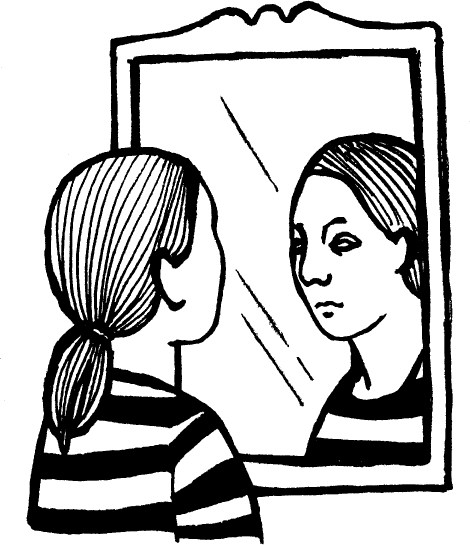
Often the best and fastest way to resolve an interpersonal conflict is by changing your own behavior.
Many people go their entire lives without learning how to communicate with others in a way that is peaceful, respectful, and mutually rewarding. I went through the first thirty years of my life thinking that to carry on a conversation meant to talk as loud and as fast as I could, and to interrupt as often as possible. I learned the hard way that this is a deeply ineffective way to share ideas with people I trust and respect.
In the decade that I have worked in activist communities, I have been to hundreds of meetings, workshops, and conference panels, and at nearly every one there was at least one person who would continually interrupt, tell long, irrelevant stories, make sexist comments, or otherwise cross the boundaries of the other people in the room. Sometimes that person was me, and I was eventually forced, by my own desire for community, to change.
The point is that if you don’t want to work with pushy, obnoxious people who interrupt everyone and disrupt the group, then don’t be like them. The old saying “You can catch more flies with honey than you can with vinegar” is true. If you really need to be heard, wait your turn and present your case in a way that is reasonable, realistic, and easy to understand. Often when we wait to speak, others will come up with the same questions and ideas. Allowing room for this empowers the whole group and restores the balance of interaction.
In any situation try to turn problems into solutions, and never be afraid to ask for help from the community. Remember the ecological design principle “Keep your chin up.” Be proud of your role in the group and willing to grow in the interests of a healthy community ecology. When we achieve harmony within our relationships with others, we will be that much closer to achieving harmony with all of nature.
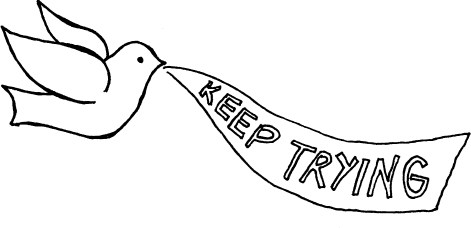
Remember, defeat is always temporary.
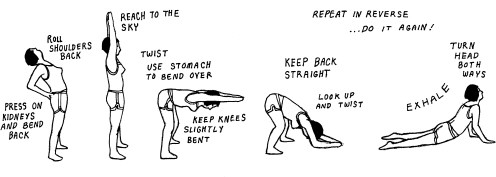
A basic daily stretching routine like the classic “sun salutation” helps support a healthy body and, in turn, a healthy attitude.
Along with checking your own behavior when things go awry in your group, taking care of yourself before interacting with others promotes healthy relationships all around. If we are not well fed, hydrated, well rested, and free from abuse, we will find it much more difficult to change our lives or our communities for the better. We owe it to ourselves, our collectives, and our planet to take the best possible care of our bodies, hearts, and minds.
One of the best ways to cover all of these bases is to garden. Gardening is great exercise and generates fresh, nutritious food, both of which are important for maintaining a strong, healthy body. In addition, gardening helps us reconnect with nature and is an excellent form of mental therapy: Working with plants has a calming effect and leads to valuable insights about how to deal with internal, emotional conflicts. Beyond gardening, also try stretching, dance, deep breathing, and professional counseling to work through your issues and find the peaceful egalitarian in yourself.
Talk It Out
Once you have gotten to the heart of the issue in yourself, if you still feel angry or uncomfortable about a person or situation, you may need to talk it out. Usually a short conversation is enough to reestablish a basis of unity and get the process flowing again. It helps to go back to notes from previous meetings, backtracking to where the problems began. Then look for alternative ways of working that don’t cause conflict within the group.
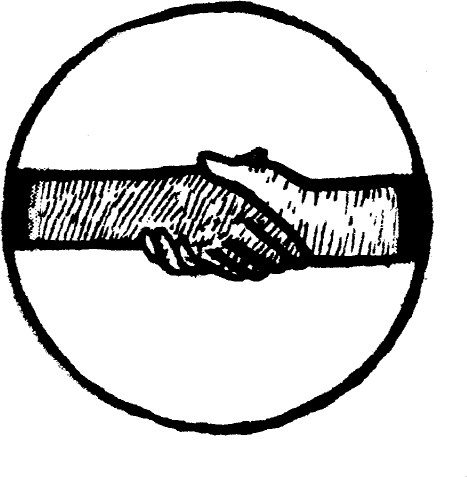
Work with people you respect, and respect the people you work with.
Sometimes the collective may need to bring in an outside mediator to negotiate issues between people and break up clotted lines of communication. Other times personal issues crop up between individuals in the group. Personal conflicts within a collective can stem from a wide range of issues, from race, religion, and economic status to unintended slips of the tongue that cause a flood of pent-up resentment to spill forth.
If you find yourself in a situation where people have become unable to communicate or work together for any of these reasons, do your best to depersonalize the conversation and return the group to the collective goals. Try the useful clearing technique outlined in the sidebar, and suggest that everyone take a break to reflect and gain better control of their emotions.
Above all, remember: You can control only your own behavior. Offer suggestions and become a calm place within the storm, but don’t try to change, fix, or control your companions. If the group becomes so dysfunctional that you find yourself sucked into unhealthy or abusive behaviors, consider moving on to a group that works better for you.
Set Healthy Boundaries
It is usually worth it to spend time resolving conflict rather than letting a project or relationship fall apart. Sometimes, however, people will cross the line from dysfunction or discomfort to flat-out abuse. As an individual and in groups it is important to set healthy boundaries and to define what constitutes abusive and oppressive behaviors.
As we work together to build a more peaceful, more ecological society, we must develop ways to communicate with one another that encourage honesty, participation, and mutual aid. Never yell at or physically attack another person. This is abuse, and it does not lend well to egalitarian group process.
It is up to you to establish a healthy way of dealing with your group and the problems that arise. If you become overwhelmed, annoyed, disenchanted, or any of the other negative emotions frequently associated with group process, perhaps you aren’t setting appropriate boundaries.
Decide what you can and can’t do, and what you are and are not willing to deal with. Unless you are called to do social work, dealing with chronic abusers is probably not worth your time. Draw the line and stick to it. If you feel you have tried communicating with someone and she continues to cross your boundaries, you are totally justified in asking her to seek counseling, nonviolence training, massage, therapy—whatever it takes. Sometimes an intervention is needed, or a person will be asked to seek professional counseling before returning to the group. If no one else in the group will back you up, check your own behavior again or consider moving on.
Let us go back to the definition of ecological design: Ecological design is a design system for ecological living, with particular emphasis on the relationships among the needs, elements, and participants within that system. The core of ecological living is relationships, whether with ourselves, other humans, or the land or between elements in a system. A successful ecological design depends entirely upon the success of the relationships within. If you want to improve your system, improve the relationships.
Most of us did not learn about egalitarian group process as children and must struggle to define and redefine our roles in each evolving project and the relationships within. However, we can and must learn to get along if we are to build a healthy future, and we can and must teach these values to our children. This is the topic of the next chapter.